The Electricity Sector in a Changing Climate
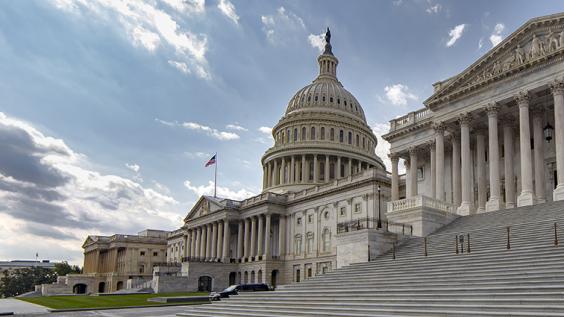
Table of Contents
Author(s)
This testimony was delivered before the U.S. Senate Committee on Energy and Natural Resources at its hearing on “The Electricity Sector in a Changing Climate” on March 5, 2019.
The broad array of topics that can be covered under the umbrella of the “The Electricity Sector in a Changing Climate” is massive, and the subject matter in its entirety is certainly timely. Covering topics related to infrastructure, costs and emissions runs the gamut from capacity investment to grid design to system/facility operations. Each is quite different but interrelated. Some understanding of this complexity can be had by examination of the history of how and why electric power grids developed in the first place, and how they have evolved since.1 The point that grids developed to balance loads across regions and increase reliability of service in disparate utility regions is an important one, and it is related to more general conversations about the role of trade in enhancing energy security. Indeed, the lessons of the past have profound bearing as our energy systems, policy-makers and system operators prepare for the future.
Given the breadth of issues that can be explored, this exposition will focus on what has transpired since 1990 – with regard to observed trends in electricity generation by source – and the role of infrastructure. This will highlight how important local/regional/state policy has been in re-shaping the reality of electric power markets. The importance of this cannot be overstated as historically it has often been subsumed into national-level conversations about “the future of the utility”, power sector emissions, and energy security.
More generally, the evolution of the electric power sector falls under the umbrella of “energy transitions” discussions. Thus, it should be recognized that two of the most impactful developments over the last 20 years have been (i) the shale revolution in the US and (ii) demand growth in developing Asia. Importantly, neither of these instigators of change is retiring. Rather, the full impact of each is still unfolding and will have ripple effects for domestic and international energy markets for years to come. This is an important point as it has direct bearing on developments in the US, especially with regard to (i), which has made natural gas a relatively abundant, low-cost option for reducing dependence on coal in power generation.
Some Historical Perspective
In the last 10 years, the US power sector has undergone a significant transition. As indicated in Figure 1, the years prior to 2007/8 saw a fairly consistent fuel mix in the power sector, with coal capturing around 50% of the market and nuclear around 19%. During the same period, natural gas share increased from just over 12% of the market to just over 21%, representing the largest increase, while other sources saw either declining (petroleum and other gases and hydro) or flat market but small shares (biomass, geothermal, wind and solar). Since 2007/8, a radically different reality has unfolded. To begin, both the use of coal and coal’s market share have declined precipitously while the absolute quantities, as well as shares, of natural gas, wind and solar have all increased.
While the shifts in power generation witnessed across the US over the last decade are noteworthy, it is important to note that the realities are different in different regions. In fact, this can begin to shine a light on the drivers of the changes witnessed at the national level. For example, renewable portfolio standards are policy mechanisms that remove offtake risk for renewable sources of generation – effectively guaranteeing purchase of produced electricity.
Such policies have been very effective at driving greater penetration of renewables, and newly announced more aggressive policies will likely continue this trend.2 But every state is different, with some RPS being established in distinct, localized utility areas, meaning local preferences can drive what is observed at an aggregate level.3
Figure 1 — U.S. Electricity Generation by Source (Quantity and Share), 1990–2017
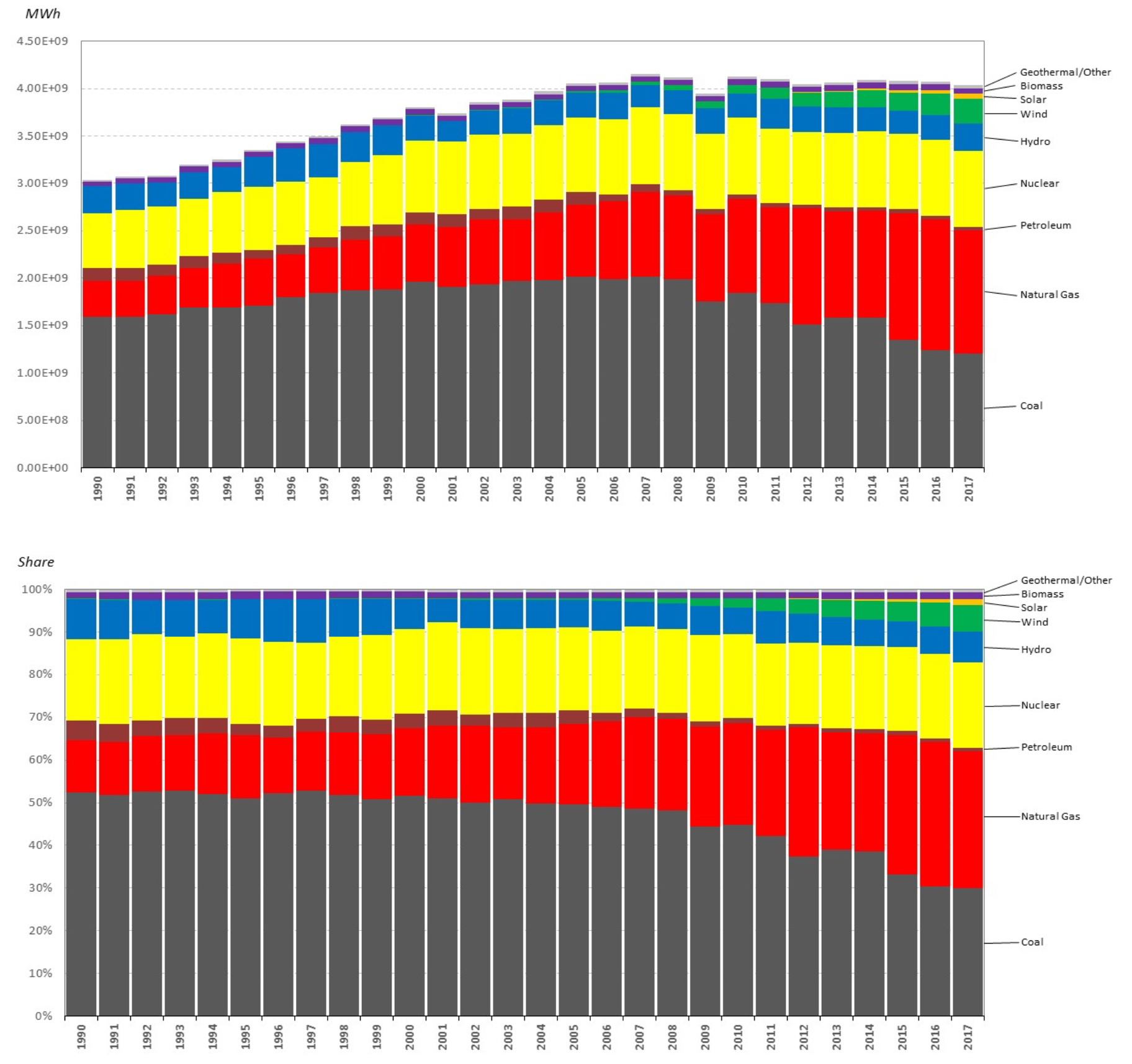
Figure 2 — Electricity Generation by Source by Select Region, 1990–2017
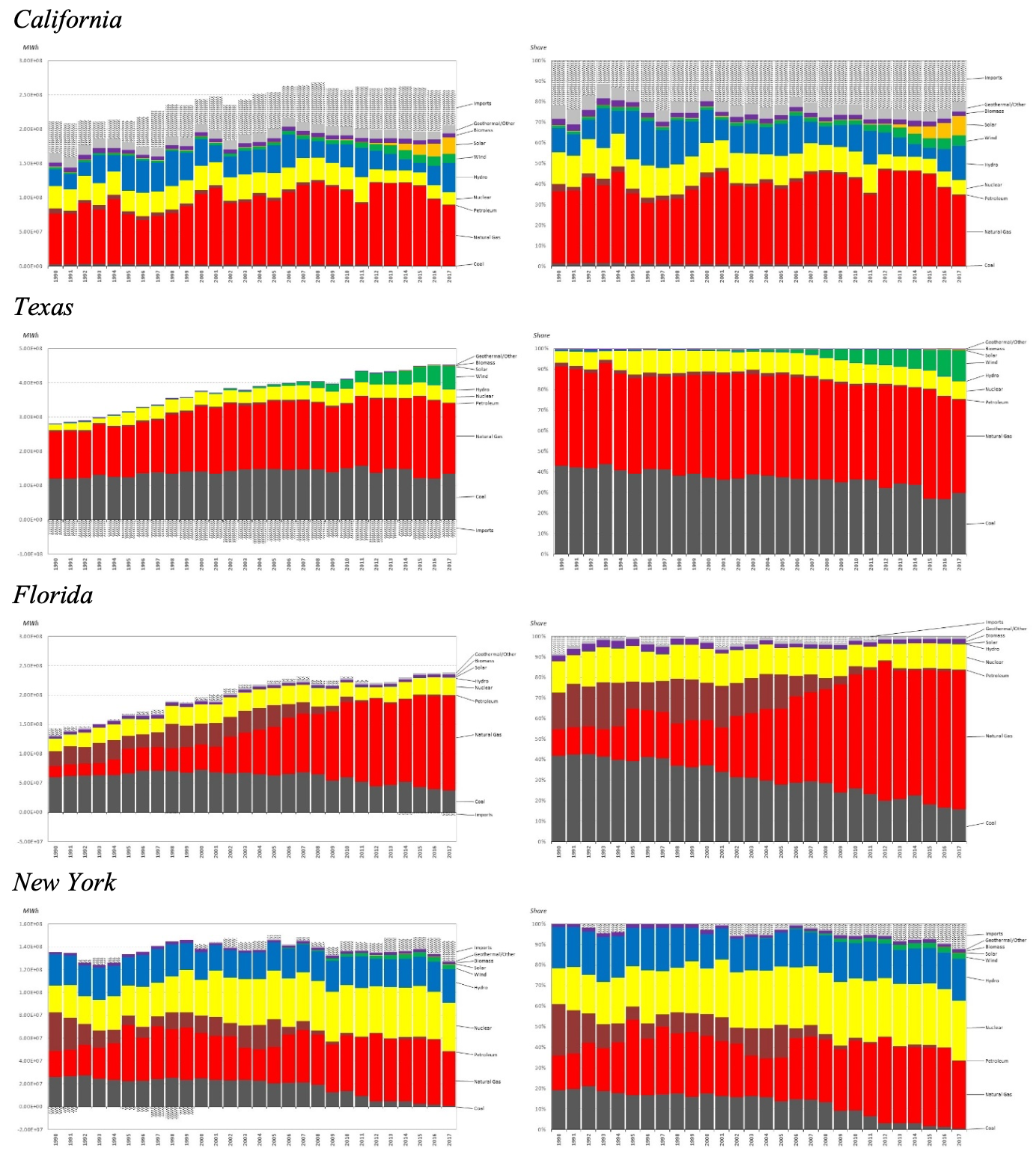
Consider the cases of California, Texas, Florida and New York (see Figure 2). Each state has seen a shift away from coal, but at different rates and for different reasons. This heterogeneity cannot be ignored. For example, California’s coal-fired generation has been minimal since 1990, and it primarily resided in combined heat and power applications. In addition, very aggressive energy efficiency programs and significant imports have allowed in-state generation to remain relatively flat while wind and solar take increasing shares. Of course, the source of imported power generation is critical when assessing the net impact of the observed trends in California on total emissions. This is where policy in California has been proactive, with AB32 attempting to address emissions from all sources of electricity sold in the state.4 The only caveat is that sources of power generation outside the state are fungible, so contracted power and delivered power need not be from the same source. Nevertheless, the approach taken in California is forward-looking insomuch as it is considering sources of imports as well as in-state generation. Texas has experienced a different path than California.
Texas has witnessed a slight decline in coal use, while natural gas and wind have risen significantly. In terms of share, coal has declined more significantly as natural gas and wind have captured the margin of growth from the increase in total power generation. Something that sets Texas apart from other states is the fact that the majority of the state is in ERCOT, which is largely disconnected from neighboring reliability council regions. So, the ability to trade with neighboring states is limited.
A point worth expounding here (and raised in previous testimony5 ) is the interdependent role of regulatory environment and infrastructure that is highlighted by the Texas experience. Wholesale and retail competition were introduced in Texas with Senate Bill 7. Competitive pressures in the retail power sector subsequently forced firms to differentiate themselves by offering specific technologies and energy services. This has, in turn, benefitted wind generation. To be clear, wind capacity investments have benefitted greatly from overt policy support – such as municipal utility RPS as well as investment tax credits and production tax credits – but they have also been propelled by consumer demands that have been made explicit through active marketing of renewable energy by retail providers. As wind capacity investments have grown, massive transmission infrastructure investments have also been required to connect resources to consumers, the cost of which is ultimately passed through to consumer bills. Similarly, some retail energy service providers have expanded their offerings into the introduction of smart technologies and distributed generation assets, which represent infrastructure investments at the commercial and residential levels. Thus, the regulatory and market environment along with the expansion of infrastructure have been critical for unlocking wind resource opportunities and pushing distributed generation and energy efficiency (albeit to a lesser extent) in Texas.6
Florida has also seen a significant decline in the use of coal in power generation. Moreover, while Florida used to see a lot of in-state power generation from petroleum, that is no longer the case. Natural gas use has grown substantially, and accounts for virtually all of the displacement of coal and petroleum in the power sector. To compound the role that natural gas has played in Florida, power generation has grown (just as in Texas) at an appreciable clip over the last couple of decades, meaning natural gas is not only displacing other sources of generation, it is also capturing new margins of growth. Notably, renewables still only account for a very small fraction of generation in Florida.
New York represents yet another different circumstance. New York has seen its use of coal and petroleum decline, just as in other states. The observed increase in natural gas use in New York effectively accounts for all of the decline in petroleum use. Wind and solar have increased slightly, but the increase in wind and solar only account for about 17% of the decline in coal use from its apex, while imported electricity accounts for about 64%. Hence, the fact that New York is grid-connected to other regions (including Canada) has allowed it to reduce its in-state generation carbon footprint. However, as noted above for the case of California, the source of the imported generation is important when considering the net implication for emissions.
We could continue in this manner to expound on the differences across all states, but the point should now be apparent. Differences in political and regulatory incentives, differences in market structures, differences in economic realities, and differences in resource opportunities all vary across states and regions. As such, the approaches to power sector management and operation have varied. The common threads across all locales are (i) the declining costs of renewables that have altered the competitive landscape and aided more rapid adoption, (ii) the low cost of natural gas relative to other fuel choices, and (iii) the importance of infrastructure investments to new generation technologies at scale and connect them to consumers in an integrated manner, the latter of which is especially vital for fluid integration of non-dispatchable resources such as wind and solar.
An Important Instigator of Change – The Role of Legacy
Serendipity has afforded a significant amount of what has been observed across states/regions. At the center of this is the role the legacy plays across the energy industry, much less the electric power sector. To begin, the last major build-out of coal-fired generation capacity in the US was in the late-1970s to early-1980s. This was driven by energy security concerns in the post-1970 oil-shock world as well as concerns about declining natural gas resources. Nevertheless, as this capacity was added to the US generation fleet, a high dependence on coal for power generation was effectively locked-in for the next three to four decades.
Fast-forward to 2008. An aging coal fleet begins to see its competitive advantage compromised with the shale revolution. Moreover, significant investments in natural gas combined cycle generation capacity in the early 2000s provided a nascent source of demand for low cost natural gas to begin to displace coal. We now sit at the 40th birthday of a large fraction of the nation’s coal capacity. As such, power producers have an economic decision to make about the existing coal fleet – retire and replace or upgrade and retrofit. As long as natural gas remains low cost and renewables continue to see cost improvements, this decision is relatively easy – retire and replace. Moreover, a transition away from coal can happen fairly rapidly because of the age (legacy) of the coal fleet. Advances in storage technologies have the potential to exacerbate this impact, especially if they can effectively regulate the delivery of power from non-dispatchable renewable resources.
The pace of retirements of coal capacity will vary by region, even if policy were not different. This is because the age of coal capacities varies by region, and the availability of natural gas at low cost (which can be hindered by inadequate pipeline capacity – more on this below) coupled with natural gas-fired generation capacity also varies by region. Layer over this the different approaches to power sector regulation and market structure that exist across states, and the heterogeneity of possible outcomes across regions expands. But this simply highlights other important instigators of change that have been referenced above – the roles of policy and regulation.
Of course, as generation capacity is turned over, certain infrastructures may become obsolete – such as rail lines and coal mines – but other infrastructures are needed to facilitate a smooth turnover. In the current US market, this includes new power plants, new pipelines, and new power lines and expanded grids, all of which will establish a new legacy for US power markets that is reliable and has lower emissions intensity.
The Importance of Infrastructure
Infrastructure plays a very important role in the commercialization of new energy technologies and resources. In fact, the deployment mechanism for new technology is capital investment in infrastructure. Absent such investments, which are often required at considerable scale, new technology remains “on the bench” seeking answers or incentives for deployment. In sum, infrastructure is vital for well-functioning markets. It plays a critical role in connecting producers and consumers, and if deep, well-functioning markets are desired, then sufficient infrastructure is critical. For investments to develop new supplies to happen, infrastructure that facilitates market access is vital. Accordingly, the absence of sufficient infrastructure can disrupt investment and have bearing on whether there is adequate and reliable supply available to end-users.
Infrastructure investments need not only be in supply, generation and delivery. Investments in storage technologies/capacities and energy efficiency technologies are also infrastructures that have bearing on the delivery of energy services to consumers. For example, energy efficiency can be enhanced through infrastructure investments in “smart” technologies that convey real time pricing data to consumers thus allowing them to adjust consumption patterns in response. When this occurs, it can reduce overall electric system load and allow existing generation resources to operate in ranges that maximize system redundancy and reliability.
Trade between regions via power lines enhances market function and adds elements of reliability and security of supply for consumers. A simple illustration rooted in trade theory can demonstrate this point.7 Consider two regions that could be connected by infrastructure to facilitate trade, but initially are not. In Region A, there is an abundance of available supply relative to demand. In Region B, there is less supply available relative to demand. As indicated in Figure 3, absent the ability to trade, prices across the regions will be set independently, and markets will balance at the indicated prices, P*A and P*B .
Figure 3 — Two Regions: No Infrastructure and No Trade
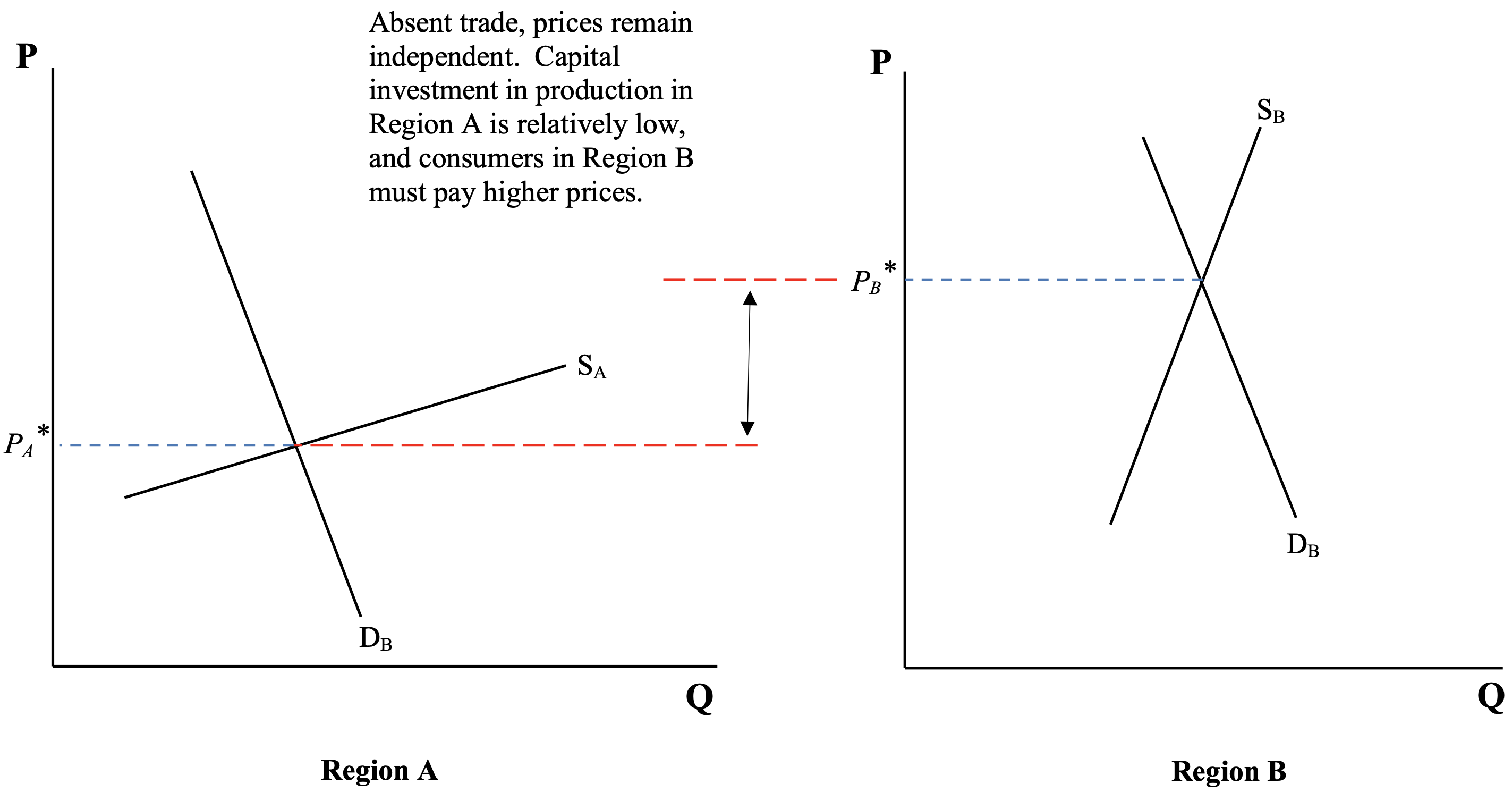
However, as indicated in Figure 4, if we introduce the physical ability to arbitrage the price differences between Regions A and B, the prices in each region will be set simultaneously, rather than independently, and the markets will clear at PA ′ and PB ′, where the difference between prices reflects the cost of transport between the two regions. Notably, when infrastructure does not exist, the effective cost of trade (shadow cost) is infinite, so prices in the two regions can float through a very wide range.
The same thing is true if infrastructure is limited and insufficient. If trade via new or expanded infrastructure is possible, it increases the likelihood that investment will flow into Region A to facilitate more production. Lower prices through trade also incentivize investments in Region B that accommodate greater demands. The exact movements of prices in each region will depend on the relative elasticities (price responsiveness) of supply and demand in each region, which will also determine the amount of trade that occurs (and infrastructure that is required).
Figure 4 — Two Regions: Adequate Infrastructure and Trade
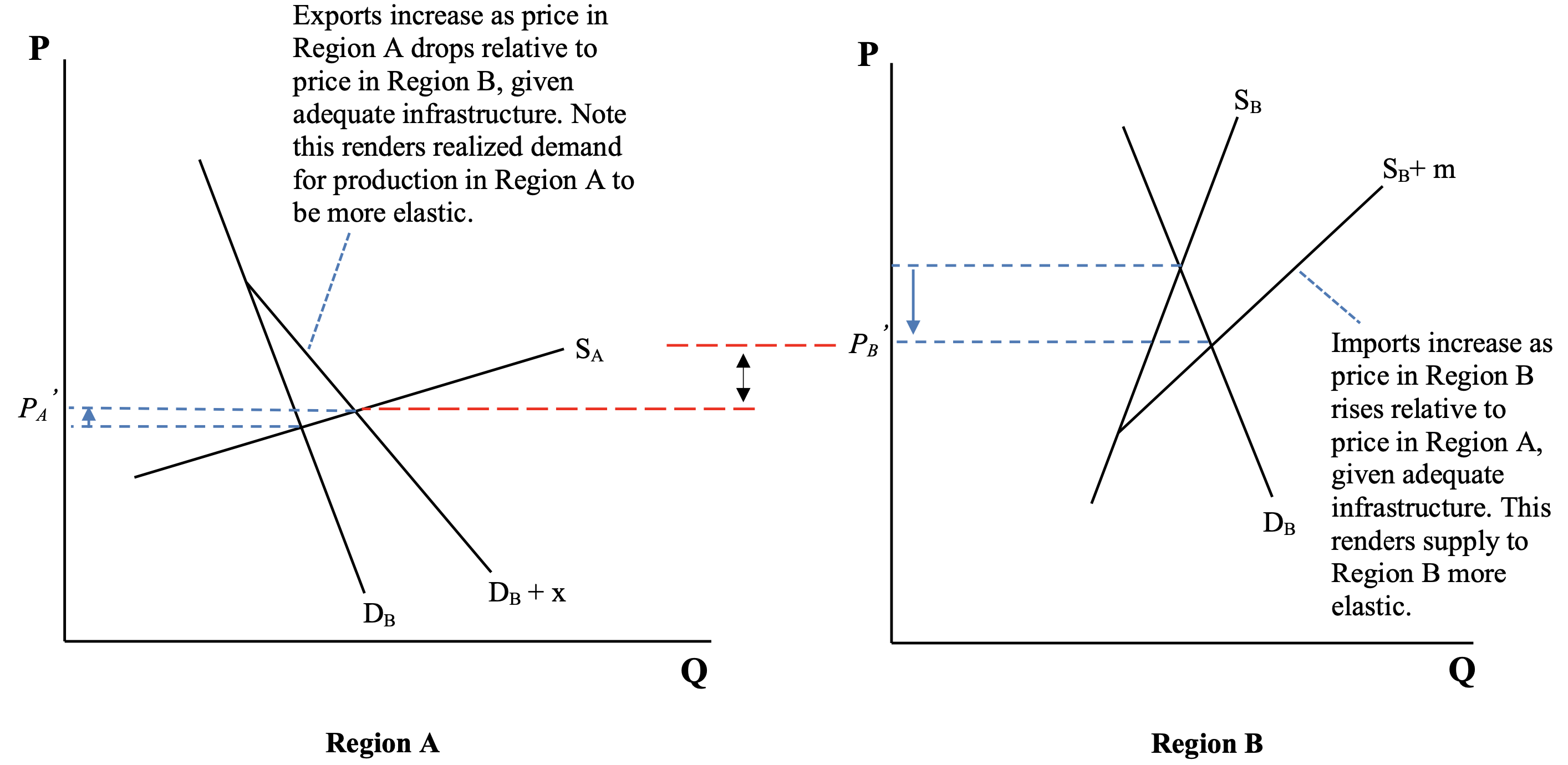
To stop here does not fully explain the value of infrastructure for price formation and supply availability across the two regions. Notice, in Figure 4, how the elasticities (slopes) of supply in Region B and demand in Region A are affected when there are no impediments to trade. If we allow demand to vary through time – daily, weekly, seasonally, etc. – as is generally the case for electricity, price volatility is dampened and supply availability is enhanced, all else equal, when trade is allowed. This is a very important point as one considers wider adoption of renewable energy sources, especially since variability in the delivery of electricity can be generated by natural factors – wind blowing and sun shining. Hence, capturing geographic differences in the availability of non-dispatchable renewable resources as well as dispatchable thermal resources can provide a very important balancing effect for power markets by allowing a seamless substitution of generation resources. In fact, wholesale electric power markets have been doing this for years, but the introduction of new variable generation infrastructures have the potential to be disruptive to the status quo while adding another element of diversification to the overall grid. Maximizing the benefits requires a grid that can overcome regional imbalances smoothly via trade.
When infrastructure is insufficient, short term movements in supply and demand can result in significant price dislocations. Consider, for example, Figure 5. Here, we see a region that initially has sufficient capacity to deliver energy for a given demand schedule, then a shift in demand results in existing infrastructure being insufficient (see Step 1 in Figure 5). The result of the realization of the deliverability constraint8 is a significant increase in price even though actual consumption may not rise very much. Notably, if electricity demand swings on a daily, weekly or monthly basis this can result in excessive price volatility as the constraint is realized and relaxed frequently.
Figure 5 — The Role of Capacity Constraints in Price Formation
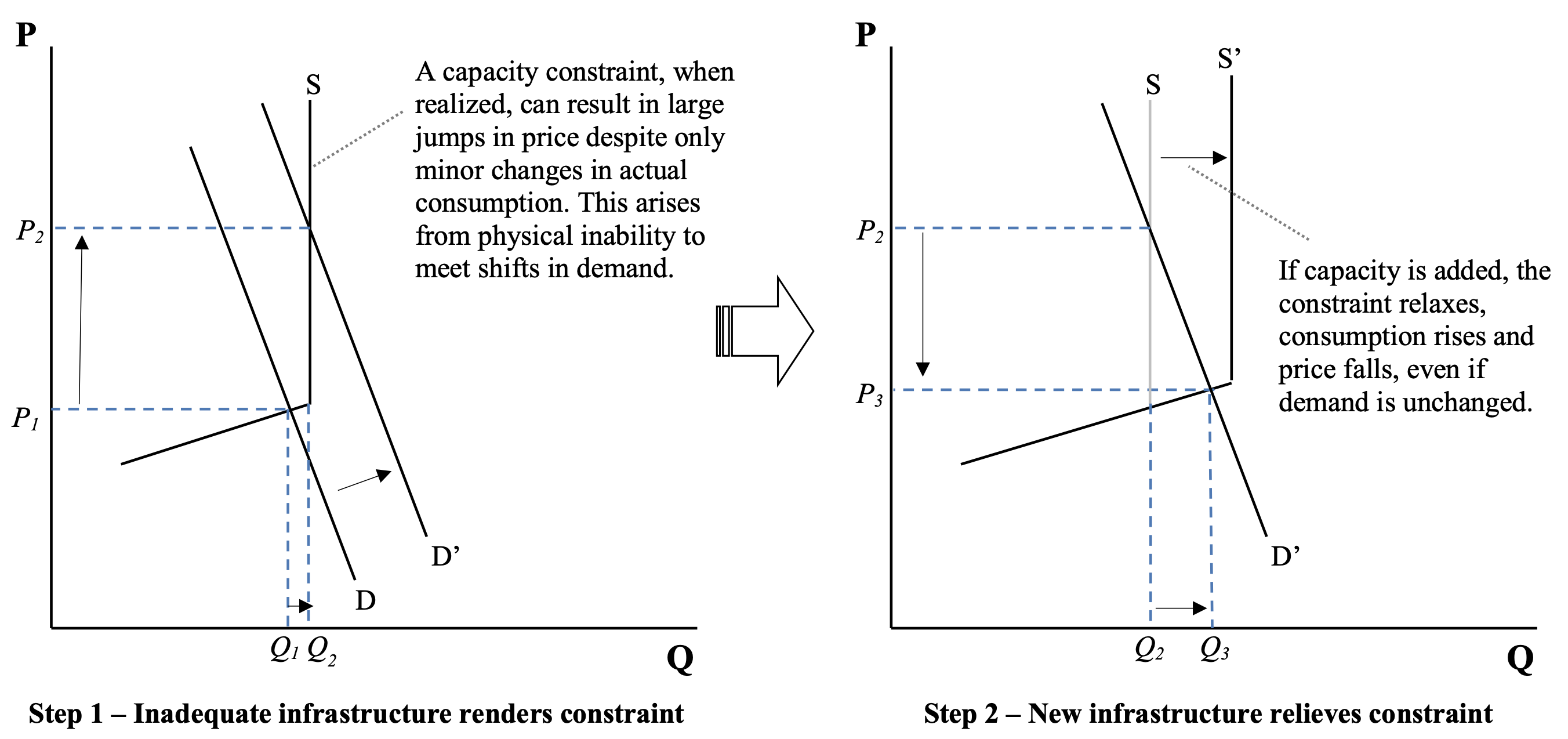
If we add delivery capability to the market, the constraint is relaxed, even at the higher level of demand (see Step 2 in Figure 3). In both cases (Steps 1 and 2 depicted in Figure 5), the market clears where available supply equals demand, resulting in a market clearing price and quantity. But, in the case where the deliverability (supply) constraint is relaxed, price is lower, greater consumption is facilitated and price volatility is dampened.
Closing Remarks
There are some new and emerging developments that have the potential to be very transformative. As one example, electrification of the vehicle fleet poses infrastructure challenges with regard to power generation and transmission capacity and recharging outlets. In the near term, the existing generating fleet is likely sufficient to meet almost any expectation of electricity demand growth associated with electric vehicle (EV) adoption. Current recharging infrastructure is also likely sufficient for low levels of EV penetration, but as more consumers drive EVs, scale effects begin to take hold and more recharging infrastructure will be required. The location of re-charging stations also becomes relevant for long distance travel. As EV penetration increases, the resulting requirements for new electric generation capacity – regardless of fuel type – will be significant.9 And, the sources of power generation required will be diverse – ranging from renewable energy sources to natural gas. Accordingly, this highlights the importance of infrastructure – additional power generation and distribution capacity as well as new natural gas pipeline infrastructures and supplies.
Politics are local. Addressing broad goals of emissions reduction while seeking reliable electricity supply to consumers must recognize this. If top-down approaches are taken, the risk of disenfranchising particular segments of the population can be large, especially if the approach does not recognize local comparative advantages. Indeed, this can ultimately derail the policy approach, as well-intentioned as it may be. Thus, approaches aimed at creating opportunities that leverage local comparative advantages should be explored. If one can design policy that is flexible, it may allow a wide array of regional approaches that accomplish a broad goal. But such policy approaches are likely to be less prescriptive and more incentive-based, which raises the specter of using price signals – such as taxes, tax credits, etc. – to drive future investments.
Endnotes
1. At the Baker Institute, we are currently involved in research that is more fully exploring this important yet underappreciated aspect of the ongoing evolution in electric power markets. This research is ongoing and will be published during the summer of 2019.
2. See https://www.eia.gov/todayinenergy/detail.php?id=38492 for some analysis by the EIA on this.
3. See http://programs.dsireusa.org/system/program?type=38& for a comprehensive listing of RPS.
4. See https://www.arb.ca.gov/cc/ab32/ab32.htm for more information.
5. See Senate Energy and Natural Resources (SENR) testimony on Energy Infrastructure from February 8, 2019. This is available at the SENR website or https://www.bakerinstitute.org/research/medlock-testifies-energy-hearing/.
6. See “Electricity Reform and Retail Pricing in Texas” (June 2017) by Peter Hartley, Kenneth Medlock, and Olivera Jankovska, available online at https://www.bakerinstitute.org/research/north-american-energy/
7. This point is expounded in previous SENR testimony on Energy Infrastructure from February 8, 2019. This is available at the SENR website or https://www.bakerinstitute.org/research/medlock-testifies-energy-hearing/. We reintroduce this concept here because it is very relevant to the broader discussion of “The Electricity Sector in Changing Climate.”
8. “Deliverability constraints” refer to constraints on access to capacity, which can result if physical capacity is short or if capacity is rendered unavailable through other means. In any case, the result is an increase in price.
9. See, for example, “Energy Market Consequences of Emerging Renewable Energy and Carbon Dioxide Abatement Policies in the United States,” by Peter Hartley and Kenneth B Medlock III (Sept 2010), available at https://www.bakerinstitute.org/research/energy-market-consequences-of-emerging-renewable-energy-and-carbon-dioxide-abatement-policies-in-the/.



